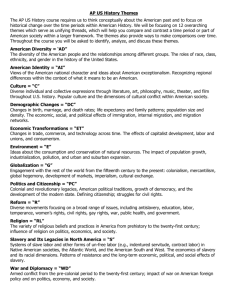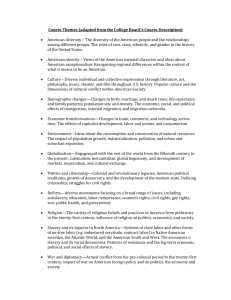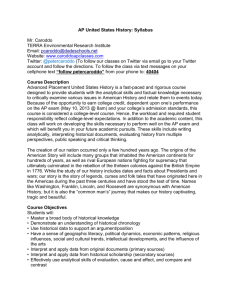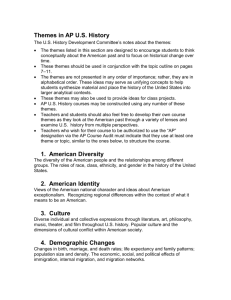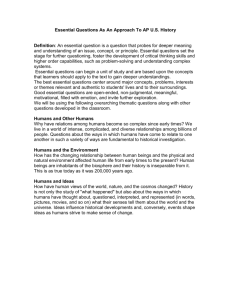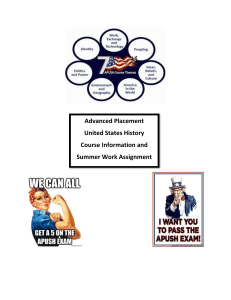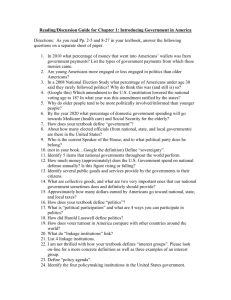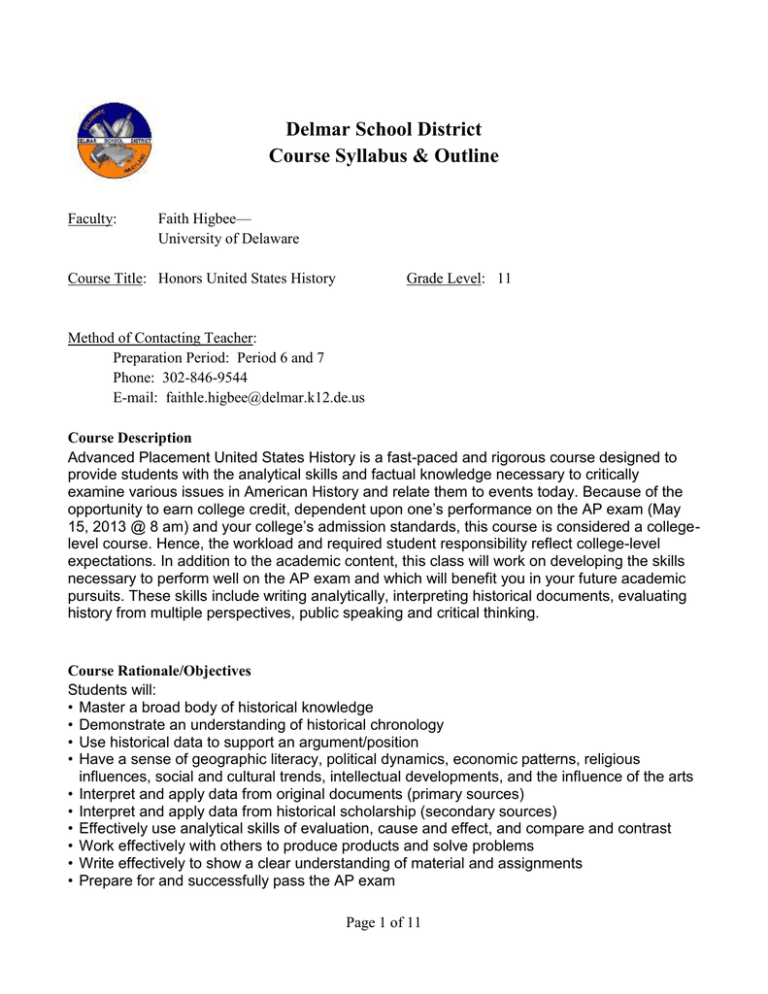
Delmar School District
Course Syllabus & Outline
Faculty:
Faith Higbee—
University of Delaware
Course Title: Honors United States History
Grade Level: 11
Method of Contacting Teacher:
Preparation Period: Period 6 and 7
Phone: 302-846-9544
E-mail: faithle.higbee@delmar.k12.de.us
Course Description
Advanced Placement United States History is a fast-paced and rigorous course designed to
provide students with the analytical skills and factual knowledge necessary to critically
examine various issues in American History and relate them to events today. Because of the
opportunity to earn college credit, dependent upon one’s performance on the AP exam (May
15, 2013 @ 8 am) and your college’s admission standards, this course is considered a collegelevel course. Hence, the workload and required student responsibility reflect college-level
expectations. In addition to the academic content, this class will work on developing the skills
necessary to perform well on the AP exam and which will benefit you in your future academic
pursuits. These skills include writing analytically, interpreting historical documents, evaluating
history from multiple perspectives, public speaking and critical thinking.
Course Rationale/Objectives
Students will:
• Master a broad body of historical knowledge
• Demonstrate an understanding of historical chronology
• Use historical data to support an argument/position
• Have a sense of geographic literacy, political dynamics, economic patterns, religious
influences, social and cultural trends, intellectual developments, and the influence of the arts
• Interpret and apply data from original documents (primary sources)
• Interpret and apply data from historical scholarship (secondary sources)
• Effectively use analytical skills of evaluation, cause and effect, and compare and contrast
• Work effectively with others to produce products and solve problems
• Write effectively to show a clear understanding of material and assignments
• Prepare for and successfully pass the AP exam
Page 1 of 11
Major Learning Goals/Standards
Students will employ chronological concepts in analyzing historical phenomena [Chronology].
Students will analyze historical materials to trace the development of an idea or trend across space
or over a prolonged period of time in order to explain patterns of historical continuity and change.
Students will gather, examine, and analyze historical data [Analysis]. Students will develop and
implement effective research strategies for investigating a given historical topic. Students
will examine and analyze primary and secondary sources in order to differentiate between
historical facts and historical interpretations.
Students will interpret historical data [Interpretation]. Students will compare competing historical
narratives, by contrasting different historians' choice of questions, use and choice of sources,
perspectives, beliefs, and points of view, in order to demonstrate how these factors contribute to
different interpretations.
Students will develop historical knowledge of major events and phenomena in world,
United States, and Delaware history [Content]. : Students will develop an understanding of
modern United States history, its connections to both Delaware and world history, including:
-- Civil War and Reconstruction (1850-1877)
-- Development of an industrialized nation (1870-1900)
-- Emergence of modern America (1890-1930)
-- Great Depression and World War II (1929-1945)
-- Postwar United States (1945-early 1970s)
-- Contemporary United States (1968-present)
Students will develop an understanding of recent and modern world history and its connections to
United States history, including:
-- Intensified hemispheric interactions (1,000-1,500 AD)
-- Explorations, contact, and interactions across the world (1450-1770)
-- Revolutions, ideologies, and technological change (1750-1914)
-- The 20th Century world (1900-present)
Learning Outcomes
Students will achieve at least a 3 or better on the Advanced Placement test
Primary Textbook
Divine, Robert A. et al. America Past and Present (AP* Edition) 9th Edition, New York:
Pearson Longman, 2011.
Additional Texts
Barbour, Michael K et. al. AP* Exam Workbook to Accompany America Past and Present (AP*
Edition) 7th Edition. New York: Pearson Longman, 2005.
Page 2 of 11
Fernlund, Kevin. Document’s For America’s History Volume 1: Since 1865 7th Edition. Boston,
MA: Bedford/St. Martin’s, 2011.
Yazawa, Melvin. Document’s For America’s History Volume 1: To 1877 7th Edition. Boston,
MA: Bedford/St. Martin’s, 2011.
References and Resource Materials
Historiography
A number of readers will be utilized to provide different interpretations of US History. These
supplementary materials will enable students to fully grasp the concepts and information which
will be on the AP exam. The list is also subject to revision.
Errico, Charles J. And Oates, Stephen B. Portrait of America Volumes 1-2 10th Edition.
Boston, MA: Wadsworth CENGAGELearning, 2012.
Madaras, Larry And SoRelle, James. Taking Sides: Clashing Views in United States History,
Volumes 1 and II: The Colonial Period to Reconstruction, 14th Edition. McGraw-Hill, 2010.
Zinn, Howard. A People’s History of the United States, 1st Edition. NY: Harper Perennial,
1999.
Technology
Smart board and laptops when available
Course Outline/Curriculum Map:
UNIT 1: Colonial America pre-1492-1754
Big Picture:
How did the diversity of peoples, economics, geography and religion help create
an American identity in the British colonial regions?
Themes:
American diversity, identity, religion, slavery and its legacies
Textbook:
Chapters: 1-4
Content:
Pre-Columbian Societies
Early inhabitants of the Americas
American Indian empires in Mesoamerica, the Southwest, and the Mississippi Valley
American Indian cultures of North America at the time of European contact
First European contacts with American Indians
Page 3 of 11
Spain’s empire in North America
French colonization of Canada
English settlement of New England, the Mid-Atlantic region, and the South
From servitude to slavery in the Chesapeake region
Religious diversity in the American colonies
Resistance to colonial authority: Bacon’s Rebellion, the Glorious Revolution, and the
Pueblo Revolt
Population growth and immigration
Transatlantic trade and the growth of seaports
The eighteenth-century back country
Growth of plantation economies and slave societies
The Enlightenment and the Great Awakening
Colonial governments and imperial policy in British North America
UNIT 2: Revolutionary America, Critical Period and Constitution (1754-1789)
Big Picture:
Between 1763 and 1776, British attempts to exert control over the colonies led to
violent, organized, successful resistance.
The Articles of Confederation provided a reasonable and workable transition
from the unitary system of British rule to the federal system established under the
Constitution.
Themes:
American diversity, culture, demographic changes, economic transformations,
globalization, war and diplomacy, slavery and its legacies
Textbook:
Chapters: 4, 5 and 6
Content:
The French and Indian War
The Imperial Crisis and resistance to Britain
The War for Independence
State constitutions and the Articles of Confederation
The federal Constitution
UNIT 3: Federalists and Jeffersonian Era (1789-1820)
Big Picture
Between 1789 and 1820, conflict over the increasing power of the national
government created intensified sectional tension.
Between 1789 and 1823, geographic isolation allowed the United States to
pursue a policy of selective involvement in world affairs
Themes:
Economic transformations, politics and citizenship, war and diplomacy
Textbook:
Chapters: 7, 8, 9 (p. 248-256, 262-270)
Page 4 of 11
Content:
Washington, Hamilton, and shaping of the national government
Emergence of political parties: Federalists and Republicans
Significance of Jefferson’s presidency
Expansion into the trans-Appalachian West; American Indian resistance
Growth of slavery and free Black communities
The War of 1812 and its consequences
Compare major individuals, events in Federalist Era
Discuss states rights and federalism as they relate to this period
Describe a variety of perspectives on westward expansion
UNIT 4: The Age of Jackson and Manifest Destiny (1824-1850)
Big Picture
During the "Reign of Jackson," politics became more democratic, the power of
the presidency increased, America became more optimistic and expansionistic,
and sectionalism supplanted nationalism.
Themes:
American diversity, identity, culture, demographic changes, globalization, politics
and citizenship, reform, religion, slavery and its legacies, war and diplomacy
Textbook:
Chapters: 10, 13 (p. 359-374)
Content:
Emergence of the second party system
Federal authority and its opponents: judicial federalism, the Bank War, tariff controversy, and states’ rights
debates
Jacksonian democracy and its successes and limitations
Forced removal of American Indians to the trans-Mississippi West
Western migration and cultural interactions
Territorial acquisitions
Early U .S . imperialism: the Mexican War
Describe the acquisition of territory from 1821-1860 and locate each acquisition
Discuss states rights and federalism as it relates to this period
Describe the effect of westward expansion in the culture of Native Americans
UNIT 5: Antebellum US (1789-1860)
Big Picture:
American reform movements between 1820 and 1860 reflected both optimistic
and pessimistic views of human nature and society.
In what ways did development in transportation bring about economic and social
change in the US in the period 1820-1860?
Themes:
American identity, culture, economic transformations, slavery and its legacies,
reform, religion
Textbook:
Page 5 of 11
Chapters: 9 (p. 256-262), 11, 12, 13 (374-384)
Content:
Beginnings of Second Great Awakening
Republican Motherhood and education for women
The transportation revolution and creation of a national market economy
Beginnings of industrialization and changes in social and class structures
Immigration and nativist reaction
Planters, yeoman farmers, and slaves in the cotton South
Evangelical Protestant revivalism
Social reforms
Ideals of domesticity
Transcendentalism and utopian communities
American Renaissance: literary and artistic expressions
Describe how social, political, economic and technical changes affect the institutions of family, education,
government, economy and religion
Explain the relationship between immigrants and the rise of intolerance toward various ethnic groups
UNIT 6: The Civil War Era and Reconstruction (1850-1877)
Big Picture:
The Civil War was caused by historic economic, social, and political sectional
differences that were further emotionalized by the slavery issue.
The Civil War effectively determined the nature of the Union, the economic
direction of the United States, and political control of the country.
Themes:
Identity, politics and citizenship, reform, slavery and its legacies, American
diversity, war and diplomacy
Textbook:
Chapters: 14, 15, 16
Content:
Pro- and antislavery arguments and conflicts
Compromise of 1850 and popular sovereignty
The Kansas–Nebraska Act and the emergence of the Republican Party
Abraham Lincoln, the election of 1860, and secession
Two societies at war: mobilization, resources, and internal dissent
Military strategies and foreign diplomacy
Emancipation and the role of African Americans in the war
Social, political, and economic effects of war in the North, South, and West
Presidential and Radical Reconstruction
Southern state governments: aspirations, achievements, failures
Role of African Americans in politics, education, and the economy
Compromise of 1877
Impact of Reconstruction
Reconfiguration of southern agriculture: sharecropping and crop-lien system
The politics of segregation: Jim Crow and disfranchisement
Explain how sectionalism and the issues associated with it led to the Civil War.
Identify social, political and economic changes that resulted from the Civil War and Reconstruction.
Examine the economic, political and social status of African Americans during and immediately following
Reconstruction.
Page 6 of 11
UNIT 7: The Gilded Age: Politics and Industry (1865-1896)
Big Picture:
The Gilded Age fostered the consolidation of business, the government, and
disadvantaged economic and social classes.
Themes:
Diversity, identity, culture, demographic changes, economic transformations,
environment, globalization, politics and citizenship, reform
Textbook:
Chapters: 16 (469-471), 19 (p.548-550) 17, 18, 19 (538-548, 550-570), 20
Content:
Expansion of manufacturing and industrialization
Expansion and development of western railroads
Competitors for the West: miners, ranchers, homesteaders, and American Indians
Government policy toward American Indians
Gender, race, and ethnicity in the far West
Environmental impacts of western settlement
Corporate consolidation of industry
Effects of technological development on the worker and workplace
Labor and unions
National politics and influence of corporate power
Migration and immigration: the changing face of the nation
Proponents and opponents of the new order, e .g ., Social Darwinism and Social Gospel
Urbanization and the lure of the city
City problems and machine politics
Intellectual and cultural movements and popular entertainment
UNIT 8: Progressivism and Imperialism (1896-1917)
Big Picture:
From 1890 to 1918, the United States became increasingly active and
aggressive in world affairs.
The Progressive movement partially succeeded in improving life for average
Americans by curbing big business, making the government more responsive to
the will of the people, and enacting social welfare legislation.
Themes:
Diversity, American identity, culture, demographic changes, economic
transformations, environment, politics and citizenship, reform, globalization, war
and diplomacy
Textbook:
Chapters: 24 (p. 690-696), 22, 23
Content:
Women’s roles: family, workplace, education, politics, and reform
Roosevelt, Taft, and Wilson as Progressive presidents
Page 7 of 11
Origins of Progressive reform: municipal, state, and national
Agrarian discontent and political issues of the late nineteenth century
American imperialism: political and economic expansion
Summarize the reasons for US involvement in the Caribbean and Latin America and its impact on selected
nations and people.
Assess the social, economic and political ramification of US expansion between 1867-1914.
UNIT 9: WWI and the Roaring 20s (1917-1929)
Big Picture:
Disillusionment with the idealism of World War I led Americans to fear change
and difference and to retreat into a superficial shell of self-satisfaction.
Themes:
Identity, demographic changes, economic transformations, politics and
citizenship, reform, slavery and its legacies
Textbook:
Chapters: 24 (p. 697-717) 25, 26
Content:
War in Europe and American neutrality
The First World War at home and abroad
Treaty of Versailles
Society and economy in the postwar years
The business of America and the consumer economy
Republican politics: Harding, Coolidge, and Hoover
The culture of Modernism: science, the arts, and entertainment
Responses to Modernism: religious fundamentalism, nativism, and Prohibition
The ongoing struggle for equality: African Americans and women
Causes of the Great Depression
The Hoover administration’s response
Franklin Delano Roosevelt and the New Deal
Labor and union recognition
The New Deal coalition and its critics from the Right and the Left
Surviving hard times: American society during the Great Depression
UNIT 10: The Great Depression and WWII (1929-1945)
Big Picture:
The Great Depression and New Deal led to the expectation of government
intervention to maintain the economic stability of the nation.
Between World War II and 1960, the New Deal philosophy that the government
was a legitimate agent of social welfare became firmly embedded in the
American mind.
Themes:
Demographic changes, American identity, politics and citizenship, reform,
slavery and its legacies, war and diplomacy
Textbook:
Page 8 of 11
Chapters: 26, 27
Content:
Causes of the Great Depression
The Hoover administration’s response
Franklin Delano Roosevelt and the New Deal
Labor and union recognition
The New Deal coalition and its critics from the Right and the Left
Surviving hard times: American society during the Great Depression
The rise of fascism and militarism in Japan, Italy, and Germany
Prelude to war: policy of neutrality
The attack on Pearl Harbor and United States declaration of war
Fighting a multifront war
Diplomacy, war aims, and wartime conferences
The United States as a global power in the Atomic Age
Wartime mobilization of the economy
Urban migration and demographic changes
Women, work, and family during the war
Civil liberties and civil rights during wartime
War and regional development
Expansion of government power
UNIT 11: The Cold War Era (1945-1990)
Big Picture:
The Cold War led the United States to pursue an ambivalent policy of
confrontation, negotiation, and preventive maintenance between 1945 and 1970.
Disillusionment with the increasingly violent protest of the 1960s led to the
entrenchment of conservative ideology between 1968 and 1992.
Themes:
Diversity, American identity, culture, environment, politics and citizenship,
reform, slavery and its legacies
Textbook:
Chapters: 28-32
Content
Origins of the Cold War
Truman and containment
The Cold War in Asia: China, Korea, Vietnam, and Japan
Diplomatic strategies and policies of the Eisenhower and Kennedy administrations
The Red Scare and McCarthyism
Impact of the Cold War on American society
Emergence of the modern civil rights movement
The affluent society and “the other America”
Consensus and conformity: suburbia and middle-class America
Social critics, nonconformists, and cultural rebels
Impact of changes in science, technology, and medicine
From the New Frontier to the Great Society
Expanding movements for civil rights
Cold War confrontations: Asia, Latin America, and Europe
Beginning of Détente
The antiwar movement and the counterculture
Page 9 of 11
The election of 1968 and the “Silent Majority”
Nixon’s challenges: Vietnam, China, and Watergate
Changes in the American economy: the energy crisis, deindustrialization, and the
service economy
The New Right and the Reagan revolution
End of the Cold War
UNIT 12: The Post Cold War Era (1990-Present)
Big Picture:
Following the breakup of the Soviet Union, America's foreign policy groped for
ways to promote world peace with minimal U.S. involvement.
Technological developments between 1950 and 2000 radically altered the
economic, social, and moral fiber of the nation.
Themes:
American identity, Diversity, economic transformations, globalization, culture
Textbook:
Chapter 33
Content:
Demographic changes: surge of immigration after 1965, Sunbelt migration, and the graying of America
Revolutions in biotechnology, mass communication, and computers
Politics in a multicultural society
Globalization and the American economy
Unilateralism vs . multilateralism in foreign policy
Domestic and foreign terrorism
Environmental issues in a global context
Learning Activities:
Small and large group projects, quizzes, tests, Culminating activites
Teaching Methods:
Lecture, discussion, group work, online tutoring
Homework Policy:
All assignments are due on the date that was assigned. No late work is accepted. Make up work must be
completed within the timeframe as set by the Board of Education.
Assignments, projects, expectations:
Students are expected to participate in class every day. Unit tests, quizzes, and culminating activities will be
assigned. DBQ’s and writing assignments will also be assigned periodically
Grading, Assessment, and Evaluation Procedures:
Page 10 of 11
The point system will be used to evaluate all assessments
Delmar Middle & High School Grading Scale
Grade
A+
A
A-
Percents
98 – 100
95 – 97
92 – 94
Grade
B+
B
B-
Percents
89 – 91
86 – 88
83 – 85
Grade
C+
C
C-
Materials provided by Teacher
Text books
Materials provided by Student
Paper, pencil/pen. Online access
Page 11 of 11
Percents
80 – 82
77 – 79
74 – 76
Grade
D+
D
DF
Percents
71 – 73
68 – 70
65 – 67
Below 65

